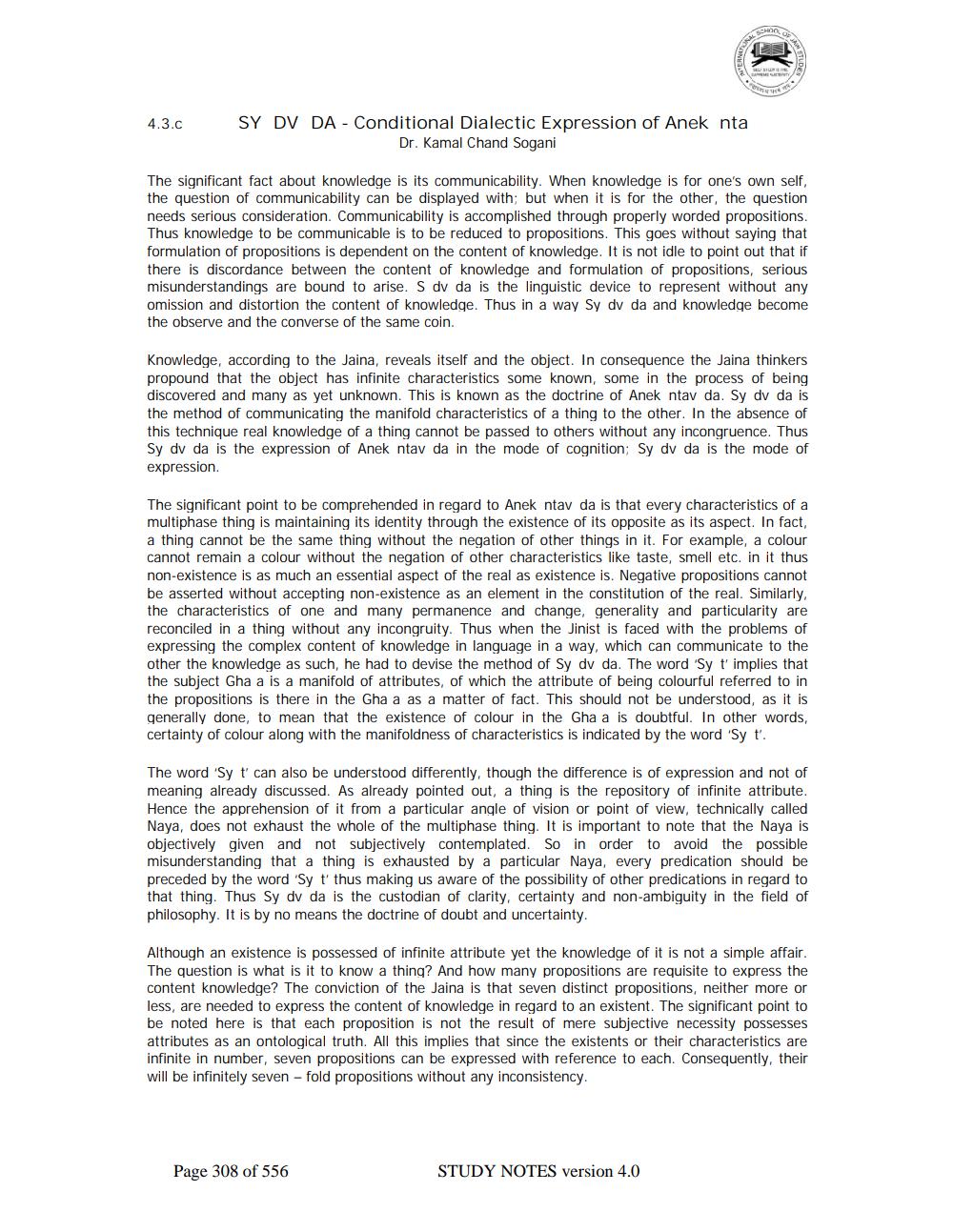________________
4.3.c
SY DV DA - Conditional Dialectic Expression of Anek nta Dr. Kamal Chand Sogani
The significant fact about knowledge is its communicability. When knowledge is for one's own self, the question of communicability can be displayed with; but when it is for the other, the question needs serious consideration. Communicability is accomplished through properly worded propositions. Thus knowledge to be communicable is to be reduced to propositions. This goes without saying that formulation of propositions is dependent on the content of knowledge. It is not idle to point out that if there is discordance between the content of knowledge and formulation of propositions, serious misunderstandings are bound to arise. S dv da is the linguistic device to represent without any omission and distortion the content of knowledge. Thus in a way Sy dv da and knowledge become the observe and the converse of the same coin.
SORS OF JAN
Knowledge, according to the Jaina, reveals itself and the object. In consequence the Jaina thinkers propound that the object has infinite characteristics some known, some in the process of being discovered and many as yet unknown. This is known as the doctrine of Anek ntav da. Sy dv da is the method of communicating the manifold characteristics of a thing to the other. In the absence of this technique real knowledge of a thing cannot be passed to others without any incongruence. Thus Sy dv da is the expression of Anek ntav da in the mode of cognition; Sy dv da is the mode of expression.
The significant point to be comprehended in regard to Anek ntav da is that every characteristics of a multiphase thing is maintaining its identity through the existence of its opposite as its aspect. In fact, a thing cannot be the same thing without the negation of other things in it. For example, a colour cannot remain a colour without the negation of other characteristics like taste, smell etc. in it thus non-existence is as much an essential aspect of the real as existence is. Negative propositions cannot be asserted without accepting non-existence as an element in the constitution of the real. Similarly, the characteristics of one and many permanence and change, generality and particularity are reconciled in a thing without any incongruity. Thus when the Jinist is faced with the problems of expressing the complex content of knowledge in language in a way, which can communicate to the other the knowledge as such, he had to devise the method of Sy dv da. The word 'Sy t' implies that the subject Gha a is a manifold of attributes, of which the attribute of being colourful referred to in the propositions is there in the Gha a as a matter of fact. This should not be understood, as it is generally done, to mean that the existence of colour in the Gha a is doubtful. In other words, certainty of colour along with the manifoldness of characteristics is indicated by the word 'Sy t'.
The word 'Sy t' can also be understood differently, though the difference is of expression and not of meaning already discussed. As already pointed out, a thing is the repository of infinite attribute. Hence the apprehension of it from a particular angle of vision or point of view, technically called Naya, does not exhaust the whole of the multiphase thing. It is important to note that the Naya is objectively given and not subjectively contemplated. So in order to avoid the possible misunderstanding that a thing is exhausted by a particular Naya, every predication should be preceded by the word 'Sy t' thus making us aware of the possibility of other predications in regard to that thing. Thus Sy dv da is the custodian of clarity, certainty and non-ambiguity in the field of philosophy. It is by no means the doctrine of doubt and uncertainty.
Although an existence is possessed of infinite attribute yet the knowledge of it is not a simple affair. The question is what is it to know a thing? And how many propositions are requisite to express the content knowledge? The conviction of the Jaina is that seven distinct propositions, neither more or less, are needed to express the content of knowledge in regard to an existent. The significant point to be noted here is that each proposition is not the result of mere subjective necessity possesses attributes as an ontological truth. All this implies that since the existents or their characteristics are infinite in number, seven propositions can be expressed with reference to each. Consequently, their will be infinitely seven-fold propositions without any inconsistency.
Page 308 of 556
STUDY NOTES version 4.0




